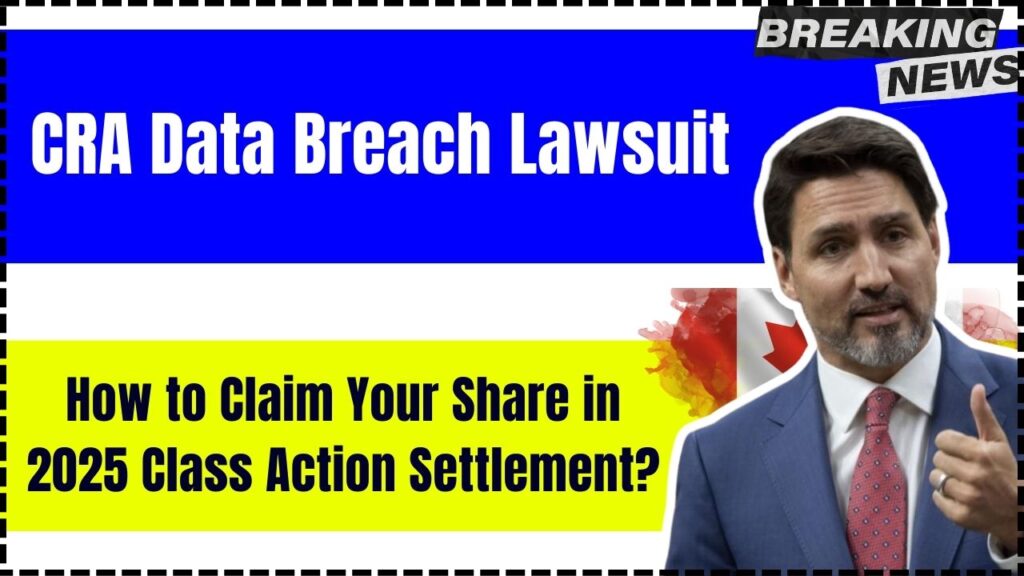CRA Data Breach Lawsuit: In recent years, data security has become a hot topic—especially when it involves sensitive personal details like Social Insurance Numbers and banking information. One major incident that raised alarm bells happened between March and December 2020, when the Canada Revenue Agency (CRA) experienced a serious data breach. This unauthorized access affected thousands of Canadians and led to a class action lawsuit.

Fast forward to 2025: the case has reached a settlement, and eligible individuals now have a chance to claim their share of compensation. Whether you’re a professional, a retiree, or just someone wanting to protect your personal information, here’s everything you need to know—clearly explained and easy to follow.
CRA Data Breach Lawsuit
| Aspect | Details |
|---|---|
| Incident Period | March 1 – December 31, 2020 |
| Who’s Eligible | Anyone whose CRA or GCKey account was accessed without authorization |
| Compensation Includes | Reimbursement for losses, credit monitoring, emotional distress damages |
| How to Claim | Submit a claim form with supporting documentation |
| Deadline | To be confirmed by court approval notices |
| What You’ll Need | Government notices, bank records, proof of fraud (if any) |
The 2025 CRA class action settlement offers much-needed relief to Canadians affected by a major data breach. If your personal or financial information was compromised, now is the time to act. The claims process is straightforward, and compensation can make a real difference—whether it’s financial recovery, credit protection, or peace of mind.
What Happened? A Quick Recap of the CRA Breach
The breach occurred due to stolen usernames and passwords that allowed unauthorized access to CRA accounts, My Service Canada accounts, and GCKey services. These accounts held extremely sensitive information, including:
- Full names and birthdates
- Social Insurance Numbers (SIN)
- Tax return history
- Direct deposit banking details
In many cases, victims were unaware until they saw strange transactions or received suspicious messages.
Am I Eligible to Claim Compensation For CRA Data Breach?
You may be eligible if:
- Your CRA or government account was accessed without permission during the breach period.
- You received notification from CRA that your data was compromised.
- You did not opt out of the class action by the legal deadline.
Even if you didn’t suffer financial loss, you could still qualify for emotional distress damages or free credit monitoring.
Types of Compensation Available
The settlement includes a variety of benefits depending on the extent of harm:
1. Financial Loss Reimbursement
You can claim money if you spent your own funds on:
- Fraud protection services
- Replacing ID or bank cards
- Legal or credit repair fees
2. Credit Monitoring Services
Eligible individuals may receive a subscription to a credit monitoring plan, which tracks credit activity and alerts you to suspicious changes.
3. Emotional Distress Compensation
If you suffered stress, anxiety, or mental hardship due to the breach, you might qualify for a fixed or tiered compensation.
How to File Your Claim For CRA Data Breach
Filing a claim doesn’t have to be complicated. Here’s how to do it:
Step 1: Gather Your Documents
- Find any CRA letters or emails notifying you of the breach.
- Collect proof of related financial transactions, such as bank statements or screenshots.
- Note any costs or emotional hardship you experienced.
Step 2: Fill Out the Official Claim Form
- This form will ask for your name, address, CRA ID (if available), and details about the breach.
- Choose your compensation type—financial loss, emotional distress, or both.
Step 3: Submit Your Claim
- Submit the form online or via mail before the deadline.
- Make sure all supporting documents are included.
Step 4: Wait for Approval
- Claims may take several months to process.
- Once reviewed, you’ll be contacted about your compensation.
How Much Can You Expect to Receive?
There’s no one-size-fits-all answer, but compensation can range based on:
| Impact Level | Example Scenarios | Estimated Compensation |
|---|---|---|
| Minor | Inconvenience, password resets | $50–$150 |
| Moderate | Fraud monitoring, ID replacement | $150–$500 |
| Severe | Verified fraud, mental hardship | Up to $2,500+ |
These are ballpark figures and may vary depending on your claim and supporting evidence.
Protect Yourself Going Forward
Even with a settlement, it’s smart to stay vigilant. Here’s how to prevent future breaches:
- Use strong passwords and avoid repeating them across accounts.
- Enable two-factor authentication (2FA) on all financial and government logins.
- Check your credit reports regularly for suspicious activity.
- Limit what you share online, especially on public forums or social media.
Canada TFWP Reform: Stricter LMIA Rules & Job Categories Changing in 2025!
Everything You Need to Know About Personal Loans in Canada
2025 Canada Disability Benefit Bill – Check Important Details and Official Payment Dates!
FAQs About CRA Data Breach Lawsuit
Q1: What if I didn’t get a letter from CRA?
You may still be eligible. If you noticed suspicious activity on your account during the breach period, you can include that in your claim.
Q2: Is this compensation taxable?
Generally, reimbursements for damages aren’t taxable—but it’s best to speak to a tax advisor for clarity on your specific situation.
Q3: Do I need a lawyer to file a claim?
No, the process is designed to be user-friendly and self-guided. But legal support is available if you need help.
Q4: Can I submit more than one claim?
You may submit multiple claims if you had multiple affected accounts or suffered various types of damage—but each must be backed by valid documentation.








